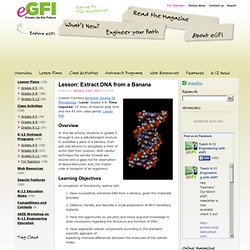

Dolan DNA Learning Center. Lesson: Extract DNA from a Banana. (Lesson Courtesy American Society for Microbiology.)

Level: Grades 5-9. Time required: 25 mins. of teacher prep time and one 45 min. -class period. Lesson PDF Overview In this lab activity, students in grades 5 through 9 use a salt/detergent mixture to solubilize a piece of a banana, then add cold ethanol to precipitate a froth of white DNA from solution. Learning Objectives At completion of this activity, learner will: 1. 2. 3. 4. Standards Standard A: Science as Inquiry – In completion of this activity, students will investigate cell structure and the methods to extract DNA. Standard C: Life Sciences – In completion of this activity, students will examine eukaryotic cell structure and investigate the function and the structure of DNA in living organisms.
Student Prior Knowledge Materials For each group of students: 1. Vocabulary DNA: Deoxyribonucleic acid, the molecule that cells contain, carries genetic information allowing for reproduction and cell division. Background Procedure a. Guide for the Care and Use of Laboratory Animals. My Jove: Scientific procedures on video. This site is no longer active. If you are looking for JoVE, please go to You are probably here because Google accidentally crawled this page. This site is for development purposes at JoVE only. Please note: We will be upgrading the site between 11:00pm and 2:00am EST. This is a MAJOR upgrade - we are moving to new servers. Journal of Visualized Experiments (JoVE) is a video journal for biological research. Chris's testing Test 3/26/09 test test testChris's testing Test 3/26/09 test test testChris's testing Test 3/26/09 test t12 entities entered here Degrees : ° Micro : μ ampersand: & trademark: ™ TESTING Visualization of UV-induced Replication Intermediates in E. coli using Two-dimensional Agarose-gel Analysis H.
We present a procedure by which two-dimensional agarose-gel analysis can be used to identify the structure of replication intermediates that occur following UV irradiation. Collin J Lobb , Carlos A Paladini Neurosciences Institute, University of Texas at San Antonio. BSW-Home Page. Winogradsky Column. Compiled by Sarah Bordenstein, Marine Biological Laboratory The Winogradsky Column is an excellent activity, specifically for grades 5 - 12, to demonstrate the growth of microorganisms.

As a result of this activity, students will: learn about the metabolic diversity of prokaryotes, applying terms such as phototroph, chemotroph, autotroph, andheterotroph. observe the cycling of mineral elements in natural environments, particularly sulfur. discover how microbes occupy a highly specific niche depending on environmental tolerance and energy requirements. Building a Winogradsky Column is both inexpensive and effective, offering students a memorable hands-on experience. To incorporate it into your classroom, you should allow about 3 months to see observable growth patterns.
The resources below will help you get started. Online Resources Schematic view of a typical Winogradsky Column. Building a Winogradsky Column Video Demonstration. More Information. Luminol Chemiluminescence Test for Blood - How to Use Luminol to. By Anne Marie Helmenstine, Ph.D.

Updated April 07, 2015. The luminol chemiluminescence reaction is responsible for the glow of lightsticks. The reaction is used by criminalists to detect traces of blood at crime scenes. In this test, luminol powder (C8H7O3N3) is mixed with hydrogen peroxide (H2O2) and a hydroxide (e.g., KOH) in a spray bottle. The luminol solution is sprayed where blood might be found. Only a tiny amount of iron is required to catalyze the reaction. Luminol Materials luminol stock solution (2 g luminol + 15 g potassium hydroxide + 250 mL water)3% hydrogen peroxide in water (common over-the-counter concentration)potassium ferricyanide or a sterile blood lancet and sterile alcohol pad Performing the Test or Demonstration In a clear test tube or cup, mix 10 ml of the luminol solution and 10 ml of the peroxide solution. continue reading below our video Loaded: 0% Progress: 0% Notes About the Luminol Test How the Luminol Test Works.
iLabCentral - The place to share remote online laboratories. Biology Labs On-Line.